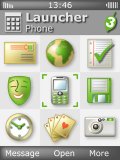Mobile User Interfaces Rant: Simplicity, Hierarchy and Cruft Prevention


So as more of the people I know start to buy and use Nokia Series 60 devices, the more I'm being called upon to explain some of the oddities and confusing bits surrounding the user interface. Though I think the S60 UI is relatively clean and useable, there are definitely a lot of friction points in the UI which cause new users problems. Not to mention problems with syncing to your PC, which I can't do and pretty much no one I know can do either (except random commenters from Finland ;-) ). It's making me think. I was one of the first people I know with an iPod mini which I posted about here... but you know what? No one has asked me about that device at all. Zero.
That may be because there's a lot less iPods out there than Series 60 phones. Yeah, you wouldn't realize it because of all the press the iPod gets like Business 2.0's breathless article this month about the "amazing" $50m iPod economy... Uh. Yeah. Series 60 phones cost more, do more and are selling three times as many devices. Like the over-coverage of the Palm, some day the print press will get a clue. I'm not sure when, but some day. But I digress...
This isn't a specific criticism of the S60 UI or the iPod, or even on the first screen shots of the new UIQ 3.0 from Symbian. This is a comment on mobile interfaces in general. Here's the thing about mobile GUIs - they have to *SIMPLE*. The best example of this which I've written about before, is the iPod. There's not a lot of people who have problems or get lost using the iPod's hierarchical user interface. Instead of navigating buttons, menus, tabs, and sections, you simply move from screen to screen in a clean, easy to remember way. It's genius.

The problem is that the mobile manufacturers aren't paying attention. Actually, I take that back - with the exception of Danger HipTop. Look at Danger's user interface: it's got a scroll wheel which brings up the main options for the user to choose from before entering that specific app. Pretty easy and clean. Too bad that Danger's phones are only selling in the hundreds of thousands, not millions like S60 phones. And look at UIQs new smart phone user interface - it's basically a clone of Series 60 devices, keeping many of the same paradigms that for most consumers just don't work. Even Cobalt sticks to it's pen-based way of navigating, with icons and menus, etc. etc. It's complexity that's going to have a hard time translating to the mass market.
Even though the iPod UI is read-only, the HipTop shows us how simply a UI can be done if we re-think how people are going to navigate around on the device. Like I wrote about before - when I tell people how to change their default soft buttons on Series 60 phones, I give them a hierarchical instructions. Menu -> Tools -> Settings -> Phone -> Standby Mode. In reality this simple set of commands translates into "press the "menu" button from the home screen, navigate the icons into the Tools folder, push the joystick in to enter the folder, navigate to the Settings icon (this is, of course, if these icons haven't been moved by the user or manufacturer), navigate to the Phone section, push in on the joystick, navigate to Standby Mode, push in, now change the settings by pressing in again and typing" Woof. On an iPod that would've been one set of commands to find the settings. Series 60 isn't the only offender of this, even RTOS phones like Sony Ericsson's T610 or Microsoft's Windows Powered Smartphones have similar User Interface commands and navigation problems.
I've come up with the basic conclusion: WIMP does not translate to mobile devices. There's got to be better ways to move around a small screen.
It's not only navigating that's the issue. It's the cruft that builds up. Ever go over a friends house who's not a techie and use their Windows PC? Oh God. it's a nightmare, no? Icons and files all over their desktop and on the root of c: drive and every other place. There's a million icons in the task tray (and they bitch about how slow their computer is), apps don't start and devices don't work like they should, etc. It's a nightmare that builds up over time with usage. This is happening on smart phones as well.
I picked up someone else's 6600 once and it was crazy. There was the missed calls, unread messages and bluetooth icons on the top of the screen. Every app he installed was sitting in his main window, many of which were expired and unusable. The GPRS settings has been changed a few times as he travelled so he had no data service. (This is only going to get worse. There are so many more apps that need server settings - web, chat, sms/mms, syncing, email, presence and more. I wrote about this before as well. Users can barely get their phone working now... how are they going to maintain all those different settings?) The worse thing was that despite the fact that he had a large MMC card, he was running out of room for his messages and photos because everything was defaulting to his phone's comparatively small memory store instead. What a mess.
The problems with syncing means that more and more photos and data are staying on the phones, the complexity of the networking setup means more phones go unused for data services, and more. I was explaining to a journalist just yesterday that the key to mobile devices is not just simplicity but payback. Applications have to have enough payback in order for the user to take time and effort to learn how to use that new app or functionality. The *really* great apps are the ones that are so simple that the payback is incedibly huge in comparision.
What do Google and SMS have in common? Think about it? The answer is "one field." Both apps only require the user to fill out just one field to make the app work. Okay, two if you count the URL and address fields, but most people have bookmarks and address books for that. For end users the payback on something *so* simple to use is huge. The rest of modern phone UIs don't come anywhere near that.
And again, this isn't a just bitch about Series 60. I look at the current UIQ and Palm OS and shake my head. Anything that needs a pen is not making things simpler, it's making them more complex. That goes for Nokia's new Series 90 which seems to be ready to launch in these pics of the 7710. That's just a big mistake - taking the worst parts from several other GUIs and combining them together for Yet Another Complex Mobile Platform. It's a waste of resources.
Okay - I will say one thing. People who use PCs are accustomed to buttons and drop downs, and check boxes, etc. But my main point is that soon the PC will be seen as an extension of the phone, not the other way around. When that happens, it's not the phone that is going to need to emulate the PC, but vice-versa. We need to think outside the current pardigms of user interface design and figure out what makes the most sense for users to learn. They need one and only one way of navigating the hierarchy of options available to them on a mobile computing device, not several. They'll learn something once, and apply it to many places. I'm sure that's some basic tenet of HIC writen somewhere out there. Then the apps have to centralize on all that miscellaneous data. Put it somewhere central where we can find and manage it. Whether it's settings data (which users shouldn't see, but practicality says they will anyways) or user generated data. That all needs to be put somewhere where it's manageable without a lot of effort. Otherwise if a user has to go to three different apps to clear out little alert icons on the main screen? They just won't do it.
-Russ